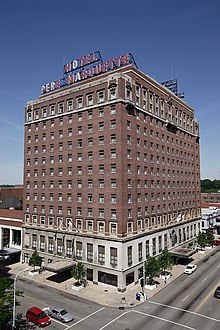Hewitt & Emerson
He was educated in the Peoria public schools and at Princeton University and MIT, graduating with a AB from the former in 1898 and a SB in architecture from the latter in 1901.
He then worked as a drafter in New York City before traveling to Paris in 1903, where he entered the Beaux-Arts atelier of architect Gustave Umbdenstock.
[3] In late 1905 he returned to the United States where he joined the New York office of Carrère & Hastings.
[4][5] Hewitt's association with the Beaux-Arts-trained Emerson may have prompted him to complete his own studies, as he returned to MIT and was awarded an SB in architecture in 1911.
He worked for architects Temple & Burrows of Davenport, Iowa, until 1919, when he joined Hewitt & Emerson as a superintendent and specification writer.
In 1940 he was appointed supervisor of the Pratt Institute School of Architecture, where he remained until relocating to Peoria in 1945.
[13] The firm designed a number of works that are listed on the National Register of Historic Places.






